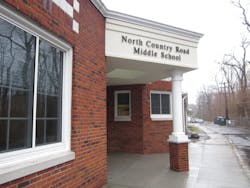Miller Place Union Free School District (UFSD) addresses security in multiple ways to keep students safe. Electronic locks and door position switches control visitor access at entrances and monitor egress to exterior classroom doors to ensure the perimeter of the facility stays secure. In addition, interior doors can be locked down simultaneously in an emergency situation.
The Miller Place School District is located on the north shore of Long Island’s Suffolk County, NY, approximately 65 miles east of Manhattan. The district encompasses more than six square miles, with a population of approximately 14,000. Its two elementary schools, a middle school and a high school serve 3,200 pupils.
In developing and implementing a comprehensive plan to upgrade security, the district worked with Architect Michael J. Guido, of Rocky Point, NY. A major concern to be addressed was the presence of exterior doors on most elementary and middle school classrooms. While primary access to the classrooms was through corridor doors, exterior doors were used for playground access and posed a potential security problem. Not only did unauthorized access need to be controlled, but the possibility of students wandering outside from the classroom undetected had to be eliminated.
Guido explains, “A six-year old could sneak out the back door into the woods, and the teacher might never know it. We put door position switches on those doors, combined with card readers, so the main office is notified any time an unauthorized door opening occurs.”
XceedID™ proximity card readers at each exterior classroom door allow a teacher to open the door to take the class to the playground without triggering an alarm. To allow emergency egress, the doors are never locked from the inside, but opening a door without a card will notify the office immediately. Guido says more than 100 doors at the elementary and middle schools have been equipped in this way.
Lockdown Capability
Each interior classroom door from a hallway has been retrofitted with a Schlage® AD-400 wireless electronic lock with integrated reader. This electronic lock enables the principal to lock down all classrooms simultaneously in an emergency. Guido points out that this is faster and easier than relying on teachers to find their keys and lock each door independently. Because the exterior classroom doors are always locked from the outside, the building can be secured completely in a matter of seconds. Electronic locks also are used on school entrance doors.
Schlage AD-400 locks, as well as XceedID card readers, are brands of Ingersoll Rand. They provide online, real-time access control and AD-400 locks are uniquely designed with easily changeable reader modules so they can be upgraded in the future without changing the entire lock. They combine all the hardware components required into one integrated design that incorporates the electrified lock, credential reader, request-to-exit switch, door position switch, tamper guard and more.
Most of the electronic locks are wireless, which simplified installation and reduced costs. “Most of the buildings are 40 to 50 years old, so pulling wires to all the doors would have been difficult and expensive. Using wireless locks made the difference between affording the whole job or just half of it,” explains plant facilities administrator Dennis Warsaw.
At the high school, a similar access control system is used, with a wireless lock or card reader and a door position switch on each door. This secures the building and prevents a student from blocking a door open or letting a friend in undetected.
The school has one exterior corridor that students use between classes. Guido notes, “The students would exit a door and enter one on the opposite side of a courtyard, so we had to build a corridor with a security vestibule.” This prevents any unauthorized individuals from gaining access.
Schlage AD-400 wireless locks enable the access control software to maintain an audit trail of when cards were used and by whom. While this has not been an issue at Miller Place yet, it can provide information on who was in a room last if something is missing, a door is left open, or other security concerns need to be addressed.
Unmarked proximity cards are used for the access credentials. Warsaw says, “We give them a card with nothing but a number, so if they lose it, anybody who finds it won’t know where they can use it.”
Controlling Visitor Access
Another issue was the need to create a controlled single-entry point for visitors. At most schools, a secure vestibule was created in close proximity to the office. Visitors must present identification before being allowed to enter. At one school, where it was impossible to construct this type of entry, a visitor must be identified before being allowed to enter a locked door.
Upon entry, the visitor must present a driver’s license to be scanned. For future visits, the person’s information is maintained in a database, which makes it possible to verify identity. Other data also can be updated, such as custodial parent issues or security concerns that would affect granting or denying future access.






